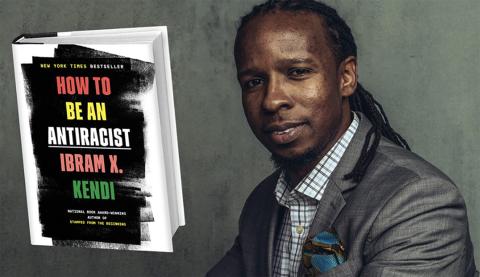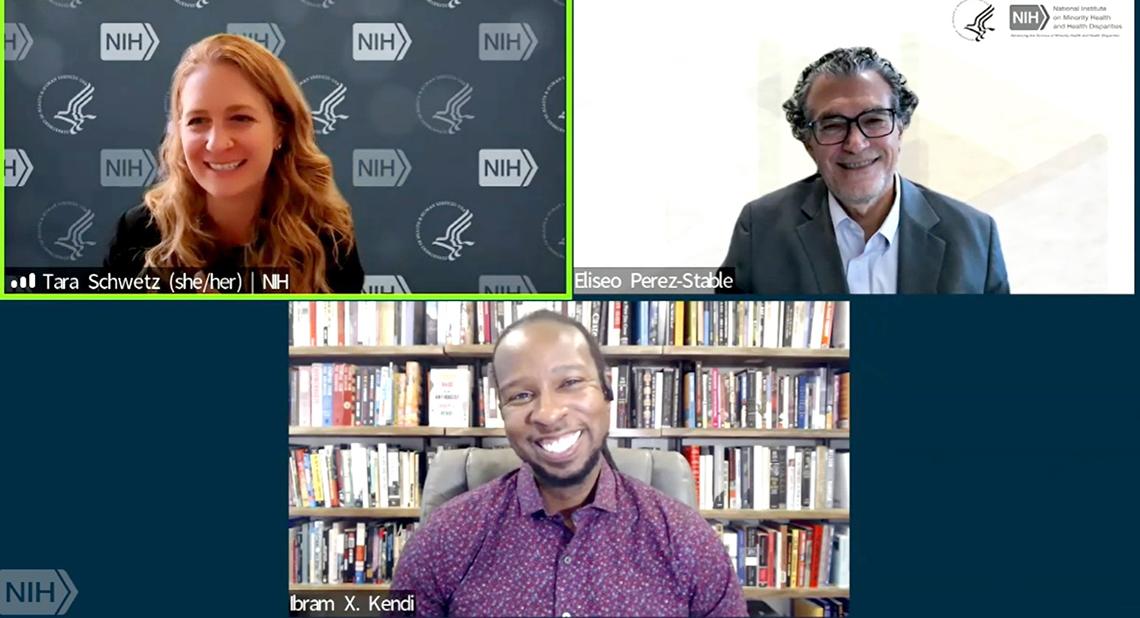The Big Read Returns
Kendi Expounds on Defeating Racism

Photo: Janice Checchio
Many people find it uncomfortable to even mention racism, but that’s what Dr. Ibram Kendi urges everyone to do. Discussing it, unabashedly and consistently, he contends, is the only way to dismantle it.
Kendi, author, professor and founding director of the Center for Antiracist Research at Boston University, spoke Sept. 27 at the NIH Big Read, an annual tradition presented by the NIH Library, the Foundation for Advanced Education in the Sciences (FAES) and the NIH Office of the Director. Each year NIH staff read and discuss an important, readily understandable book, culminating in an author event.
More than 1,200 NIH’ers tuned in live for this year’s Big Read, featuring an online conversation between Kendi and Dr. Eliseo Pérez-Stable, director, National Institute on Minority Health and Health Disparities. Dr. Tara Schwetz, NIH acting principal deputy director, also joined the chat.
“Like fighting an addiction,” Kendi wrote in his 2019 bestseller How to Be an Antiracist, “being an antiracist requires persistent self-awareness, constant self-criticism and regular self-examination.”
During the Big Read, he urged everyone “to enter into these conversations with a level of humility, with an openness to transformation.”
Kendi states unequivocally there is no in-between. Ideas and policies are either racist or antiracist. A society has racial hierarchy or equality; policies are inequitable or equitable. But when describing individual people, he noted, racist is not a permanent label or fixed category.
“Many people across history have expressed racist and antiracist ideas,” Kendi said, “sometimes in the same speech, or the same book, or the same paragraph or the same conversation.” So, how do you identify the person who is expressing these opposing views?
Kendi likened it to a doctor making a diagnosis, an affliction happening in the body that isn’t permanent. “Racist is a descriptive term—it describes what a person is being in any given moment,” he said. “Clearly, you can be treated; you can be different. Clearly, you can be healed and you can turn around and be a healer. To be antiracist is to acknowledge the times we’re being racist, because the only way we’re going to heal and be better is if we accept that diagnosis.”

For centuries, people—even scientists—have debated racial hierarchy, some arguing that each race is biologically distinct. Many have sought to dispel that myth. Scientists officially debunked the misconception with the mapping of the human genome in 2000, which confirmed all humans are 99.9 percent genetically alike.
“The work of people in NIH to bring that scientific finding to the world has been so absolutely critical for those of us who study and talk about race and racism,” said Kendi, “because we’re able to say definitively that race is a fiction and racism is a fact.”
Pérez-Stable underscored, “We all agree that race and ethnicity are social constructs; they’re not defined biologically. I like to say they can be used as tools for discovery science.”
While writing How to Be an Antiracist, Kendi was blindsided by an ominous diagnosis—stage 4 metastatic colon cancer—not long after his wife Sadiqa had endured her own cancer battle. Immersed in his research, he didn’t notice the weight loss and other related symptoms. Following treatment, Kendi is now cancer-free and a couple of months from reaching the elusive 5-year survival rate.
Drawing parallels with his racism research, Kendi wrote, “as long as the underlying cause remains, the tumors grow, the symptoms return and inequities spread like cancer cells.” But, he noted optimistically, “We can survive metastatic racism.”

Photo: Stephen Voss
One solution Kendi proposes that resonates with many NIH’ers is striving to prevent bias in research.
“One of the things I’ve tried to do through my work is allow people to understand the context in which they’re asking research questions and they’re proposing potential solutions to problems,” he said. “If [a researcher] believes that a particular racial group is culturally or behaviorally superior or inferior, that’s going to factor into what [they] consider the problem and thereby what [they] consider to be the solution.
“To presuppose that a particular racial group is dying at higher levels because of how they are behaving is to presuppose that there is something wrong with that racial group, which is to presuppose racist ideas.”
However, noted Pérez-Stable, such diseases as diabetes and cancer may be more common in one group or another, “so in many ways, [considering constructs such as race, class and ethnicity] captures something we need to leverage in our scientific inquiry.”
Kendi responded, “If we are finding a racial health disparity, then we should be investigating racism...If we’re finding a disparity between Black working-class people and White working-class people, then we should be investigating both racism and the economic system.”
When people blame class or education attainment for racial health disparities, this ignores, for example, how maternal mortality is higher for Black women with college degrees than for White women without high school diplomas. “It’s actually racism,” Kendi argues, “because you have upper-income people of color suffering worse mortality than low-income White folks.”
Toward eliminating racial barriers in research and promoting diversity, Pérez-Stable highlighted UNITE, NIH’s long-term initiative to diversify research and the workforce, to tackle structural inequities head on. Kendi applauded the effort.
In striving to build more diversity into the scientific workforce, Kendi said, some argue there are not enough people of color in the pipeline. He likened that fallacy to a college football coach trying to recruit Black athletes. It’s not the pool in academia either, he pointed out. When coaches want to increase the pool, they invest in camps and training.

Kendi’s 6-year-old daughter aspires to be a scientist. “Like my daughter, there are many people of color who are interested in this work if they only have the opportunity. And what those college football coaches are doing is creating those opportunities where they don’t exist.”
Dr. Marie Bernard, NIH’s chief officer for scientific workforce diversity, joined in to ask if Kendi had advice for UNITE’s antiracism steering committee.
Kendi recommended using longitudinal racial data to gauge whether interventions are making an impact. Beyond data, he suggested focus groups or extended interviews with staff to truly understand perceptions and feelings.
“I also think it is important for everyone to realize that these equitable initiatives are beneficial to NIH’s work, that they are going to create better science,” he said. “This isn’t just to create equity. This is to create a better NIH.”
Pérez-Stable agreed. “We do know that diversity in scientific teams leads to better science, more thoughtful science, different kinds of questions,” he said.
“I wish that as researchers,” said Kendi, “we spent our time and our money trying to investigate the whole host of policies and practices and conditions that were causing health struggles in particular communities, actually causing racial health disparities.
“There are so many brilliant minds…that if we were to shift our attention there, we would be able to discover not only the problems, but even the solutions to many of what seemingly appears to be some of the most intractable racial health disparities of our time.”
